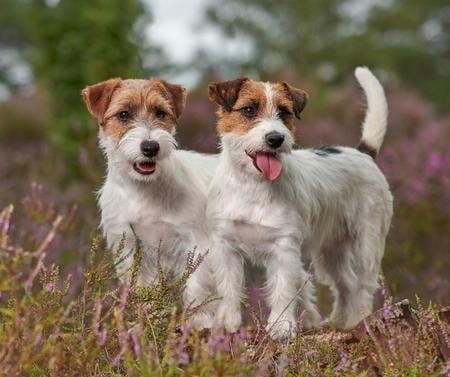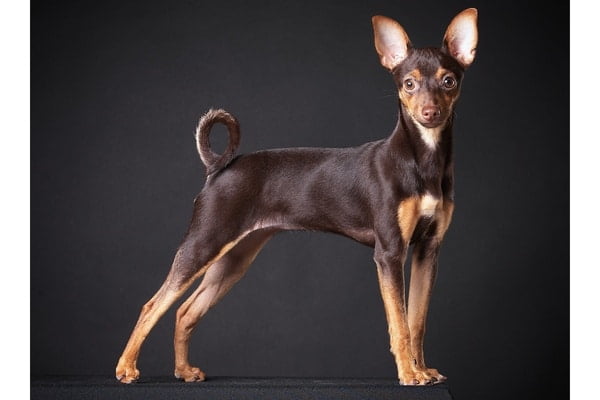The Jack Russell Terrier is a small dog with a big personality. Known for their boundless energy and intelligence, these dogs are always ready for an adventure. With their fearless nature and strong hunting instincts, they excel in various activities like agility and obedience. Despite their size, Jack Russells are full of spunk and make loyal companions.

Victorian Bulldogs: A Fascinating Breed with a Rich History and Unique Traits
Introduction: Unveiling the Victorian Bulldogs – A Fascinating Breed
Victorian Bulldogs, also known as Olde English Bulldogges, are a captivating breed with a rich history and unique traits. They are a modern recreation of the original English Bulldogs from the Victorian era, bred to resemble their ancestors in appearance and temperament.
These dogs have gained popularity in recent years due to their charming personalities and distinctive physical characteristics. In this article, we will delve into the origins, physical traits, temperament, health needs, and popularity of Victorian Bulldogs, debunking common misconceptions along the way.
The Origins: Tracing the Rich History of Victorian Bulldogs
The history of Victorian Bulldogs can be traced back to the 18th and 19th centuries when Bulldogs were popular in England. These dogs were initially bred for bull-baiting, a cruel sport that was eventually banned in 1835. However, the breed’s popularity continued to grow, and they became beloved companions and symbols of British culture.
The Victorian Era Influence: How the Breed Got Its Name
In the Victorian era, which spanned the period of Queen Victoria’s reign from 1837 to 1901, the Bulldog breed experienced a notable transformation in both its physical characteristics and its behavioral temperament. This period was marked by a shift in the role of dogs from working animals to companions, which had a direct impact on the breeding and selection of Bulldogs.
Originally, Bulldogs were bred to participate in a brutal sport known as bull-baiting, which required them to be large, aggressive, and powerful. The Bulldogs of the early Victorian era were much more robust and ferocious than the breed we are familiar with today. They had to be fierce and courageous to engage with bulls, which was not only a form of entertainment but also believed to tenderize the bull’s meat.
However, with the outlawing of bull-baiting in 1835 due to the Cruelty to Animals Act, the necessity for such aggressive traits in Bulldogs diminished. The public’s perception of dogs began to change, and there was an increasing desire for breeds that could adapt to more domesticated roles as pets and companions.
Breeders responded to this change by selectively breeding Bulldogs for qualities that would make them more suitable for indoor living and companionship. The focus shifted towards creating animals that were smaller in size, which made them easier to keep in the smaller living spaces typical of the time. In addition to size, breeders also selected for Bulldogs with a more docile and gentle temperament, moving away from the aggressive characteristics that had been valued for bull-baiting.
These breeding practices led to the emergence of Bulldogs that were more affable and less intimidating, aligning with the Victorian values of propriety and refinement. The Bulldogs became known for their loyalty, patience, and suitability as family dogs, qualities that made them highly desirable pets in Victorian households.
The term “Victorian Bulldogs” is used to refer specifically to the version of the breed that developed during this era. It serves as a tribute to the Victorian era’s profound impact on the breed’s evolution, commemorating the historical context that gave rise to the specific breed traits we associate with Bulldogs today. The Victorian Bulldog is often considered a re-creation or a continuation of the breed type that existed in the 19th century, embodying the physical and temperamental qualities that were shaped by the preferences and cultural influences of that time.
Physical Characteristics: Unique Traits that Set Victorian Bulldogs Apart
Victorian Bulldogs are medium-sized dogs with a muscular build and a distinctive, wrinkled face. They have a broad chest, strong legs, and a compact body. Their heads are large and square-shaped, with a pronounced underbite. One of the most striking features of Victorian Bulldogs is their expressive, round eyes that exude warmth and kindness.
Temperament and Personality: Exploring the Gentle and Affectionate Nature of Victorian Bulldogs
Despite their intimidating appearance, Victorian Bulldogs are known for their gentle and affectionate nature. They are loyal, loving, and thrive on human companionship. These dogs are excellent with children and make great family pets. They are also sociable with other animals when properly socialized from a young age.
Health and Care: Understanding the Special Needs of Victorian Bulldogs
Like many brachycephalic breeds, Victorian Bulldogs are prone to certain health issues. Their short snouts can lead to breathing difficulties, and they may be more susceptible to heatstroke. Regular veterinary check-ups, a balanced diet, and moderate exercise are essential for maintaining their overall health. It is also important to keep their skin folds clean and dry to prevent infections.
Training and Exercise: Nurturing the Active and Intelligent Victorian Bulldogs
Victorian Bulldogs are intelligent and eager to please, making them relatively easy to train. Positive reinforcement methods work best with this breed, as they respond well to praise and rewards. While they are not overly energetic, regular exercise is still crucial to keep them mentally and physically stimulated. Daily walks and interactive play sessions are recommended to prevent boredom and promote a healthy lifestyle.
Victorian Bulldogs as Family Pets: Why They Make Great Companions
Victorian Bulldogs are known for their affectionate and gentle nature, making them excellent family pets. They are patient and tolerant with children, making them ideal companions for families with kids. Their loyalty and protective instincts also make them great watchdogs. Despite their muscular build, Victorian Bulldogs are not aggressive and are generally friendly towards strangers.
The Breed’s Popularity: Rising Interest in Victorian Bulldogs Today
In recent years, the popularity of Victorian Bulldogs has been on the rise. Their unique appearance, combined with their loving temperament, has attracted many dog enthusiasts. According to the American Kennel Club (AKC), Victorian Bulldogs have seen a steady increase in registrations, indicating a growing interest in the breed.
Breed Standards and Recognition: Victorian Bulldogs in the Show Ring
While Victorian Bulldogs are not recognized by major kennel clubs such as the AKC or the Kennel Club (UK), they are recognized by smaller breed clubs and organizations. These clubs have established breed standards that outline the ideal characteristics and traits of Victorian Bulldogs. Breed enthusiasts often participate in shows and events organized by these clubs to showcase their dogs’ conformation and temperament.
Common Misconceptions: Debunking Myths about Victorian Bulldogs
There are several misconceptions surrounding Victorian Bulldogs that need to be debunked. One common misconception is that they are aggressive due to their appearance. However, Victorian Bulldogs are known for their gentle and friendly nature. Another misconception is that they require excessive exercise. While they do need regular exercise, they are not as high-energy as some other breeds.
Conclusion: Embracing the Victorian Bulldogs – A Breed with a Bright Future
Victorian Bulldogs are a fascinating breed with a rich history and unique traits. Their origins in the Victorian era, distinctive physical characteristics, gentle temperament, and rising popularity make them a breed worth considering for dog lovers. While they have specific health needs and require moderate exercise, their loyalty, affection, and adaptability make them excellent companions for families and individuals alike. As more people discover the charm of Victorian Bulldogs, their future as a beloved breed looks bright.



